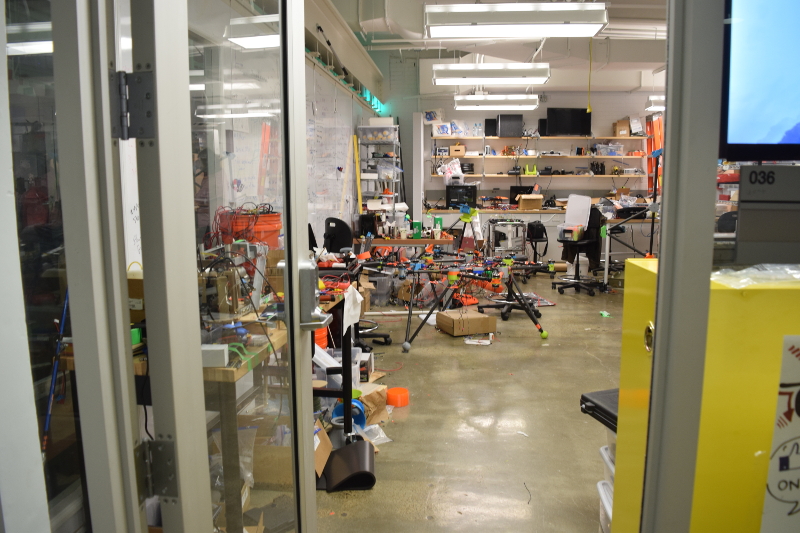Growing Student Group Promotes Drones Across Campus
By Alex Xu
Students founded a new chapter of the Academy of Model Aeronautics in response to a growing interest in drones among the student body

In recent years, the development and use of unmanned aerial systems (UAS) has skyrocketed. Commonly known as drones, these systems have wide-ranging applications from exploration and research to art and recreation. The Duke Academy of Model Aeronautics (AMA) was founded in April 2018 in response to this growing interest in drones among the student body.
As a chapter of the national AMA organization and the only student organization dedicated to promoting drone technology on Duke’s campus, Duke AMA seeks to create a space for students to explore drones and their potential applications. This includes advocating for safety while operating drones, as well as teaching students how to design and build these unmanned systems.
The original motivation for Duke AMA stemmed from work by Duke’s team in the Shell Ocean Discovery XPRIZE competition, a program aimed at advancing the development of robotic technologies in deepsea research. As part of the Ocean Engineering and Robotics class led by Martin Brooke, associate professor of electrical and computer engineering, the competition required a team of students from the Pratt School of Engineering to develop an 18-motor heavy-lift drone that was capable of carrying sensors to map the ocean floor.
Through that effort, team members and engineering students Virginia Pan and Yao Yuan saw great potential in exploring drone technology and a demand for a drone-focused campus organization. As a result, they launched Duke AMA with Brooke as their faculty advisor to bring attention to drones across Duke’s campus.

A Better Drone Policy
Duke AMA’s current work seeks to reform Duke’s campus drone policy, which the organization considers to be too limiting. Other than two designated flight sites in the Duke Forest, drone use on campus requires special approval from the Duke Drone Committee, and hobbyist use is generally prohibited. Consequently, Duke AMA has been pushing for changes including a well-defined safety code that would offer students more freedom to fly drones on campus while still maintaining the necessary regulations.
As part of its goal to improve drone safety and accessibility, Duke AMA also provides all of its members with liability insurance for piloting drones. The group has also established an indoor flight space in The Foundry, a makerspace in the basement of Gross Hall. Even students with minimal piloting experience are able to fly small-scale drones there with the protection of safety nets.
Sky-High Projects
Duke AMA also facilitates the development of new applications for drones by funding student projects. Virginia Pan, the president of the organization, says, “The aim is to inspire students to come up with their own project ideas.”
One project spearheaded by a Duke AMA team is developing a low-cost firefighting surveillance drone equipped with thermal imaging technology. They hope to make the use of drones in firefighting operations more cost-efficient, accessible and widely available. They are experimenting with a quadcopter platform and are planning to implement the technology at larger scales that may be better suited for longer-range applications, such as forest fires.
 Meanwhile, another team of students is in the initial stages of designing a drone powered by a novel power source—hydrogen. Currently, drones are typically powered by lithium polymer (LiPo) batteries. Because LiPo batteries have low energy density, and the power required by drones increases steeply as weight is added, adding more batteries doesn’t necessarily result in longer flight times.
Meanwhile, another team of students is in the initial stages of designing a drone powered by a novel power source—hydrogen. Currently, drones are typically powered by lithium polymer (LiPo) batteries. Because LiPo batteries have low energy density, and the power required by drones increases steeply as weight is added, adding more batteries doesn’t necessarily result in longer flight times.
The team is investigating the practicality of hydrogen (with a hundredfold increase in energy density compared to LiPo batteries) as an energy source to power drones. They wish to build one of the first hydrogen drone prototypes in existence and gather experimental data for analysis.
Not Just for Engineers
For Pratt’s students, Duke AMA provides an opportunity to gain hands-on, real-world experience while working with some of the latest technologies, including autonomous flight and artificial intelligence. “It’s a great way to practice what you learn,” says Yao Yuan, vice president of Duke AMA.
Because the group isn’t focused on competing in one single competition, students developing projects have increased flexibility and resources. “We give members as much freedom as possible to pursue their own interests. If you have any drone idea, we aim to help you,” Yuan adds.
As projects become increasingly multidisciplinary, however, Duke AMA is seeking non-engineering students from across the university as well. It has plans to collaborate in the future with the Nicholas School of the Environment, Innovation Co-Lab and Duke Photography Club for drone applications around campus.
Future of Drones at Duke
Besides teaching more students about drone safety, advocating for changes to campus drone policy and providing piloting training, Duke AMA hopes to expand its horizons with more projects and get even more students involved. With planned projects to optimize wing shape design for fixed-wing aircraft and build 360-degree drone cameras, the future of drones at Duke looks promising.
Alex Xu is a first-year student intending to major in electrical and computer engineering. He is passionate about aerospace, robotics and photography.
